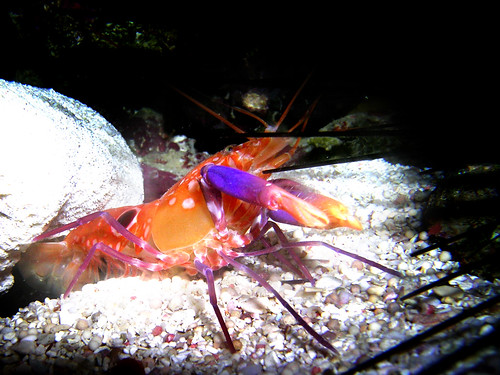Monday is here one more time and the opportunity for science talk is here once again. Time to brighten your day with selections from science sites across the globe. New discoveries, new takes on old knowledge, and other bits of news are all available for the perusing in today's information world. Today's tidbits include a new kind of industrial revolution took another step with a speedier way to produce biological factories, a new target for treating a wide range of cancers, tapeworm eggs discovered in fossil shark feces, and Aztec conquest altered genetics among early Mexico inhabitants.
Pull up that comfy chair and grab a spot near the fire. There is always plenty of room for everyone. Another session of Dr. Possum's science education, entertainment, and potluck discussion is set to begin.
Featured Stories
Biological factories offer potential uses across a broad spectrum of activity including better delivery of drugs and more productive extraction of deep minerals.
Parts made up of DNA are re-engineered by scientists and put into cells to make biological factories. However, a major bottleneck in synthetic biology is the lack of parts from which to build new types of factories. To build parts using the current time-consuming method, scientists have to re-engineer DNA in a cell and observe how it works. If it functions according to their specifications, then the scientists store the part specifications in a catalogue.
Now, scientists from Imperial College London have devised a much quicker method that does away with the need for them to re-engineer a cell every time they want to make a new part. The team say their work could lead to vast new libraries of off-the-shelf components that could be used to build more sophisticated biological factories.
As the search for
new and better treatments for cancer a new target, a pocket on the surface of the P53 protein, has been found.
In its regular form, p53 helps repair damaged DNA in cells or triggers cell death if the damage is too great; it has been called the “guardian of the genome.”
Mutant p53, however, does not function properly, allowing the cancer cells it normally would target to slip through control mechanisms and proliferate. For this reason, the protein is a key target of research on cancer therapeutics.
The ubiquitous
tapeworm is an intestinal parasite which is very old to say the least.
The fossilized eggs were found in a cluster very similar to those laid by modern tapeworms. Some of them are un-hatched and one contains what appears to be a developing larva. According to the study, "This discovery shows that the fossil record of vertebrate intestinal parasites is much older than was previously known and occurred at least 270-300 million years ago."
The fossil described in this study is from Middle-Late Permian times, a period followed by the largest mass extinction known, when nearly 90% of marine species and 70% of terrestrial species died out.
Analysis of DNA tells a tale of
Aztec influence on the original Otomí inhabitants of Xaltocan, the capital of a pre-Aztec Mexican city-state.
Historical documents suggest that residents fled Xaltocan in 1395 AD, and that the Aztec ruler sent taxpayers to resettle the site in 1435 AD. Yet archaeological evidence indicates some degree of population stability across the imperial transition, deepening the mystery. Recently unearthed human remains from before and after the Aztec conquest at Xaltocan provide the rare opportunity to examine this genetic transition.
As part of the study, (researcher) Mata-Míguez and his colleagues sampled mitochondrial aDNA from 25 bodies recovered from patios outside excavated houses in Xaltocan. They found that the pre-conquest maternal aDNA did not match those of the post-conquest era. These results are consistent with the idea that the Aztec conquest of Xaltocan had a significant genetic impact on the town.
Knucklehead's Photo of the Week
Bullseye Pistol Shrimp

©Knucklehead, all rights reserved, presented by permission. (Click on the image to see more in the same series.)
Other Worthy Stories of the Week
Scientists create a near living crystal
'Sound maps' may help pigeons navigate
Computer models explain how galaxies formed and evolved
The tail of Venus and the weak solar wind
Cool, new views of Andromeda galaxy
New method of measuring the mass of supermassive black holes
Superbubble DEM L50
Nanoparticles that look and act like cells
Amazon freshwater ecosystems are vulnerable to degradation
Planting trees may not reverse climate change but may help locally
How doe corals survive in the hottest reefs in the world?
A Virginia museum is unwrapping a mummy with CT
Clovis culture was not wiped out by a comet
Warmng waters take their toll on Antarctic shellfish
For even more science news:
General Science Collectors:
Alpha-Galileo
BBC News Science and Environment
Eureka Science News
LiveScience
New Scientist
PhysOrg.com
SciDev.net
Science/AAAS
Science Alert
Science Centric
Science Daily
Scientific American
Space Daily
Blogs:
All-GeoGeology and Earth science
Cantauri Dreams space exploration
Coctail Party Physics Physics with a twist.
Deep Sea News marine biology
List of Geoscience Blogs
Science20.com
ScienceBlogs
Space Review
Science Insider
Scientific Blogging.
Space.com
Techonology Review
Tetrapod Zoology vertebrate paleontology
Wired News
Science RSS Feed: Medworm
The Skeptics Guide to the Universe--a combination of hard science and debunking crap
At Daily Kos:
This Week in Science by DarkSyde
Overnight News Digest:Science Saturday by Neon Vincent. OND tech Thursday by rfall.
All diaries with the DK GreenRoots Tag.
Astro Kos
SciTech at Dkos.
NASA picture of the day. For more see the NASA image gallery or the Astronomy Picture of the Day Archive

Stratocumulus Clouds over the Pacific, NASA, public domain


